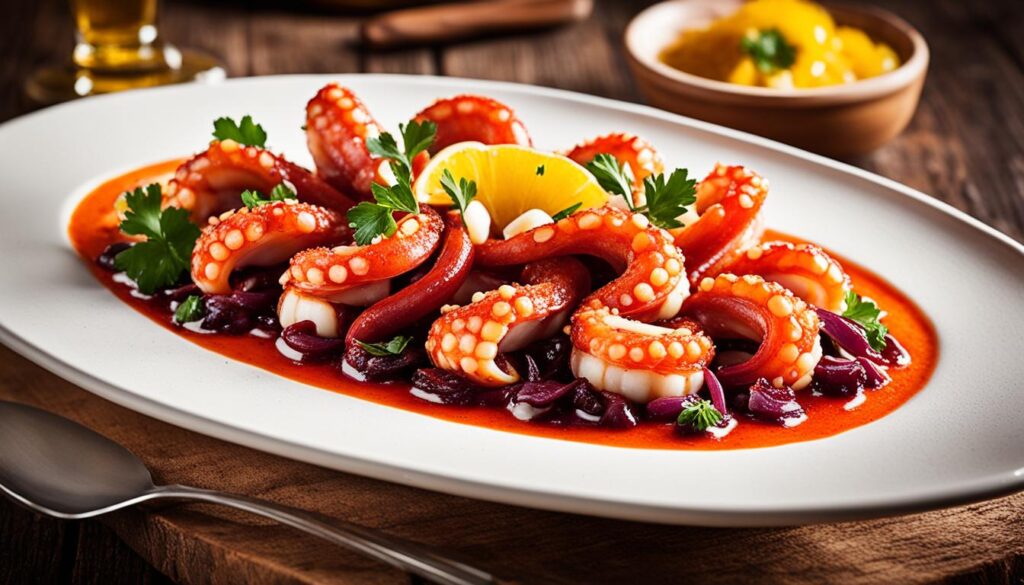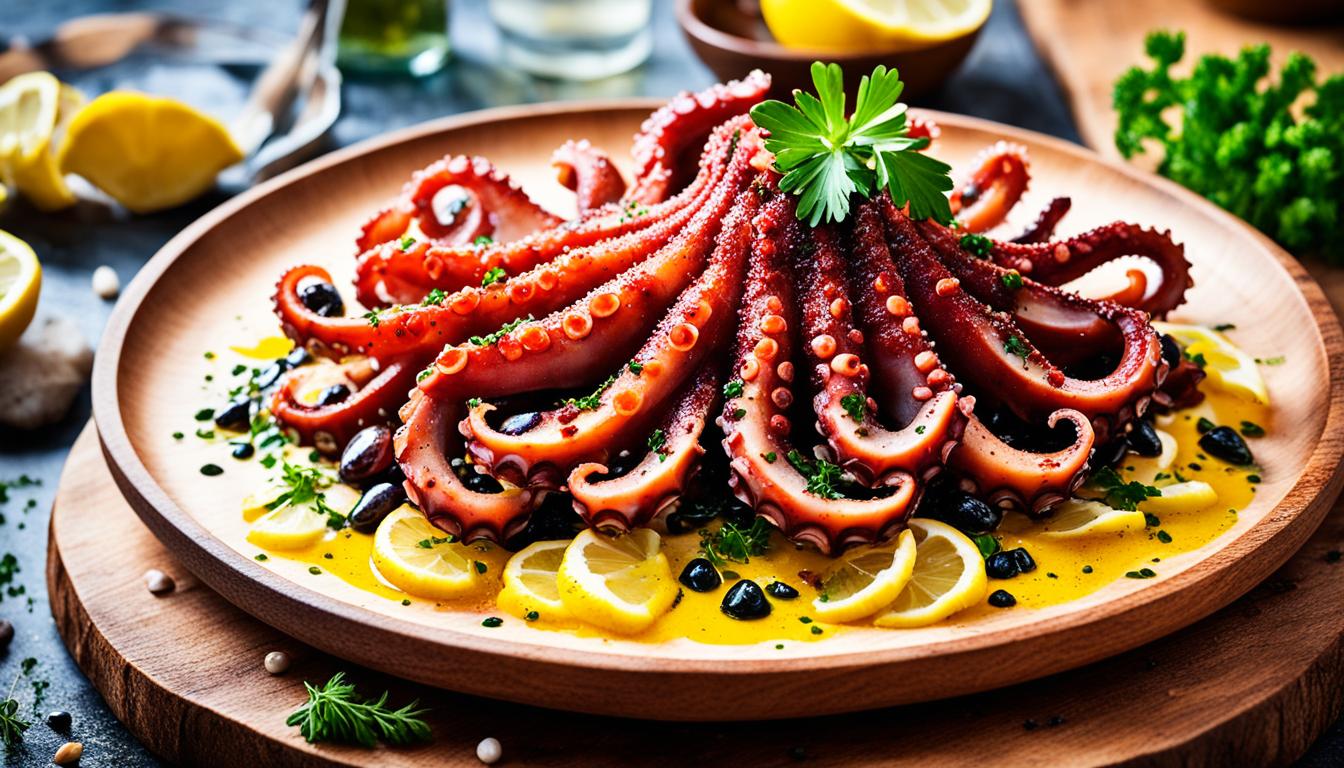Have you ever wondered how to recreate the vibrant flavors of traditional Spanish tapas in your own kitchen? Look no further than Pulpo Gallego, the authentic Galician octopus dish that is beloved in Spain and beyond. With its tender octopus, dressed in olive oil and sprinkled with pimentón de La Vera, Pulpo Gallego embodies the taste of Galicia, a region known for its rich gastronomy and love for seafood. So, are you ready to dive into the world of Galician cuisine and discover the secrets behind this tantalizing tapa?
- Learn the origin of Pulpo Gallego and its significance in Galician cuisine
- Discover the traditional methods of cooking this delectable dish
- Explore tips and variations to customize your Pulpo Gallego recipe
- Uncover the best ways to serve this authentic Galician tapa
- Experience the rich flavors and textures of Pulpo Gallego
The Origin of Pulpo Gallego
Pulpo Gallego, also known as pulpo á feira, is a traditional tapas-style dish that originated in Galicia, a region located in northwestern Spain. Galicia is renowned for its vibrant culinary scene and its bountiful seafood offerings. Octopus, or pulpo in Spanish, is a common catch for local fishermen and holds a special place in Galician cuisine. Pulpo Gallego is a staple dish in the region and is often enjoyed as a flavorful tapa or appetizer.
The dish’s popularity extends beyond the culinary realm, and it is frequently featured at festivals and fairs in Galicia. This has led to the dish being referred to as “pulpo a la feria,” a nod to its association with these vibrant celebrations. The recipe for Pulpo Gallego typically involves cooking the octopus with paprika and olive oil, two key ingredients that embody the essence of Galician cooking.
“Pulpo Gallego is a true representation of Galician culinary traditions, combining the simplicity of fresh seafood with the bold flavors of paprika and olive oil.”
To visually encapsulate this section, here’s an image of a plate of delicious Pulpo Gallego:
In Galicia, traditional Spanish tapas like Pulpo Gallego are cherished for their ability to bring people together to share good food, laughter, and stories. This dish showcases the culinary heritage and deep-rooted traditions of Galician gastronomy.
The Galician Seafood Tradition
The Galician region’s proximity to the Atlantic Ocean provides an abundance of fresh seafood, which is a cornerstone of the local cuisine. Galicians have developed a deep appreciation for the flavors and versatility of seafood, with the octopus being a particular delicacy. The Galician people’s mastery in preparing and enjoying octopus dishes has been passed down through generations, making Pulpo Gallego an essential part of their culinary heritage.
For a comprehensive understanding of the impact of Pulpo Gallego on Galician cuisine, refer to the following table:
| Galician Octopus Recipe | Traditional Spanish Tapas |
|---|---|
| Originates from Galicia, Spain | Part of the rich tapestry of Spanish tapas culture |
| Prepared with octopus, paprika, and olive oil | Offers a harmonious blend of flavors and textures |
| Often served as a tapa or appetizer | Invites a communal dining experience |
| Featured at festivals and fairs in Galicia | Emphasizes the celebratory nature of Spanish cuisine |
Cooking Pulpo Gallego
When it comes to preparing the delicious and authentic Galician dish, Pulpo Gallego, there are various methods you can use. However, the most common and convenient approaches involve using either a pressure cooker or a conventional pot. These cooking techniques not only ensure tender and flavorful octopus but also help reduce the overall cooking time.
Once the octopus is cooked to perfection, it is time to prepare it for serving. The cooked octopus should be cut into rounds and strips, allowing for easier and more enjoyable eating. Arrange the succulent octopus on a plate and drizzle it with high-quality olive oil. For an added burst of flavor, sprinkle some pimentón, or Spanish smoked paprika, and a pinch of salt. The combination of olive oil, pimentón, and salt enhances the taste of the Galician style octopus, making it a truly indulgent experience.
Pulpo Gallego can be savored as is or enjoyed with additional ingredients to create a more substantial and flavorful meal. The traditional recipe suggests serving it with sautéed onions and boiled potato slices. These accompaniments add texture and depth to the dish, transforming it into a satisfying culinary delight.
Renowned for its simplicity and the rich flavors it delivers, Pulpo Gallego has gained a well-deserved reputation as one of the best octopus recipes. The Galician twist infused into this dish captivates both seafood enthusiasts and lovers of authentic Galician cuisine.
“Cooking the octopus in a pressure cooker significantly reduces the cooking time, making it more convenient.”
Simple Steps for Cooking Pulpo Gallego:
- Cook the octopus in a pressure cooker or conventional pot until tender.
- Once cooked, cut the octopus into rounds and strips.
- Arrange the cooked octopus on a plate.
- Drizzle with olive oil.
- Sprinkle pimentón (Spanish smoked paprika) and a pinch of salt over the octopus.
- Add sautéed onions and boiled potato slices, if desired.
- Serve and enjoy!
Serving Pulpo Gallego
Pulpo Gallego is a versatile dish that is typically served as a tapa or appetizer. It holds a prominent place in Spanish cuisine, particularly in the gastronomy of Galicia. Whether enjoyed on its own or as part of a tapas spread, Pulpo Gallego delights seafood lovers and showcases the flavors of this vibrant region.
When serving Pulpo Gallego, it is common to pair it with other traditional Spanish dishes, creating a tantalizing combination of flavors. Some popular options include:
- Patatas Bravas: Crispy potatoes topped with a spicy tomato sauce and aioli.
- Croquettes: Fried balls of creamy potato or béchamel sauce, usually with a filling of ham, cheese, or seafood.
- Cheese Plate: A selection of Spanish cheeses, such as Manchego or Mahón, accompanied by crackers or bread.
To fully savor the flavors of Pulpo Gallego, it is essential to pair it with the right wine. A dry white wine or vinho verde complements the delicate taste of the octopus, enhancing the overall dining experience. Additionally, serving the dish with crusty bread is an excellent way to soak up the delicious juices and enjoy every last bite.
Testimonials:
“Pulpo Gallego is a favorite dish of mine whenever I visit Galicia. The tender octopus, combined with the flavors of olive oil and paprika, creates a truly unforgettable taste sensation!”
– Maria Lopez, Food Enthusiast
“I love how Pulpo Gallego is such a versatile dish. You can enjoy it as a tapa or add it to a larger spread of Spanish delicacies. It always brings a taste of Galicia to the table!”
– Carlos Martinez, Culinary Explorer
Overall, serving Pulpo Gallego allows you to immerse yourself in the rich culinary traditions of Galicia and experience the flavors that make Spanish seafood dishes so beloved.
| Spanish Seafood Dishes | Galician Gastronomy |
|---|---|
| Gambas al Ajillo | Pulpo a Feira |
| Paella de Marisco | Pimientos de Padrón |
| Bacalao al Pil Pil | Tarta de Santiago |
Tips and Variations
When making Pulpo Gallego, we emphasize the importance of using good quality ingredients to enhance the flavors of this authentic Galician dish. Traditional Spanish tapas like Galician octopus recipe rely on the perfect combination of flavors to create a truly memorable culinary experience. Here are some tips and variations to help you elevate your Pulpo Gallego:
Tips:
- Choose high-quality Spanish paprika: The distinct smoky flavor of pimentón de La Vera enhances the taste of Pulpo Gallego. Opt for authentic Spanish paprika to capture the traditional essence of the dish.
- Use extra-virgin olive oil: Olive oil is a staple in Galician cuisine and adds a rich and fruity note to the dish. We recommend using extra-virgin olive oil for its superior taste and quality.
- Fresh or frozen octopus: Depending on availability, you can use either fresh or frozen octopus for your Galician octopus recipe. If using frozen octopus, ensure that it is properly thawed before cooking to maintain its texture.
Variations:
Pulpo Gallego is an adaptable dish that allows for personal touches while preserving the authentic Galician flavors. Here are some variations to consider:
- Grilled or broiled octopus: After cooking the octopus, you can grill or broil it for a few minutes to achieve a charred flavor and add a smoky element to your dish.
- Add roasted peppers: For a burst of color and additional flavor, consider adding roasted bell peppers to your Pulpo Gallego. The sweetness of the peppers complements the savory octopus.
- Infuse with garlic: If you’re a garlic lover, infuse your olive oil with crushed garlic cloves before dressing the octopus. This will impart a subtle garlic flavor throughout the dish.
These variations allow you to put your own spin on the traditional Galician octopus recipe while still honoring the essence of authentic Galician cuisine. Don’t be afraid to experiment and discover your favorite combination of flavors!

| Tips | Variations |
|---|---|
| Choose high-quality Spanish paprika | Grilled or broiled octopus |
| Use extra-virgin olive oil | Add roasted peppers |
| Fresh or frozen octopus | Infuse with garlic |
Conclusion
Pulpo Gallego is not just a dish; it is a culinary masterpiece that embodies the rich flavors and traditions of authentic Galician cuisine. This Galician style octopus, also known as pulpo a la gallega, is a true representation of the gastronomic heritage of the region.
With its tender octopus, drizzled with the finest olive oil and sprinkled with the exquisite flavor of Spanish paprika, Pulpo Gallego is a symphony of taste and texture. Whether enjoyed as a tantalizing tapa, a delightful party appetizer, or a centerpiece in a lavish Spanish feast, Pulpo Gallego brings the authentic taste of Galicia to your plate.
Indulge your senses with this classic pulpo a la gallega recipe and savor the unmistakable flavors of Galicia. With every bite, you will be transported to the picturesque coastal towns of Galicia, where the sea meets the land, and culinary traditions are passed down through generations. Experience the magic of authentic Galician cuisine and discover why Pulpo Gallego is a beloved dish that captures the heart and palate of anyone who tries it.
